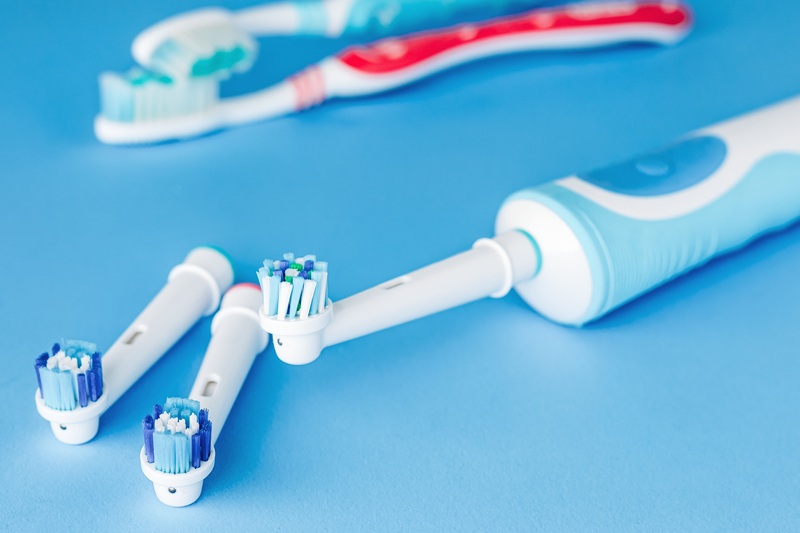The Battle Between Manual vs. Electric Toothbrushes: Which Cleans Better?

With so many options on the shelves, it can be overwhelming to choose the right toothbrush for you. One of the many questions asked by our patients is, “Should I stick with my trusty manual, or is it time to go electric?”
While both promise a sparkling smile, which one actually delivers the better clean?
As dentists, here’s our take on this debate between manual vs electric toothbrush. We will share with you the science behind these two types of brushes and help you choose the brush that works best for your smile, lifestyle, and budget.
Keep reading because you might be surprised by what matters most.
The Real Purpose of a Toothbrush?
Before we dive into the debate between manual and electric toothbrushes features and technology, it’s important to understand what a toothbrush is actually meant to do.
A toothbrush is designed to clean the outside and inside surfaces of your teeth by removing plaque, which is a soft, sticky film of bacteria that builds up daily. However, it does not clean between your teeth, which is a job for dental flosses or interdental brushes.
So when comparing manual vs electric toothbrushes, the real question becomes: Which one makes it easier to clean thoroughly, gently, and consistently?
Let’s look at each one of their features and benefits to better understand what they can offer.
The Manual Toothbrush: Simple but Effective
Pros of a Manual Toothbrush:
A manual toothbrush is the first one introduced to us and the most straightforward kind. Here are some of the pros of a manual toothbrush:
- Affordable (you can find great ones for $3 or less)
- Widely available
- Easy to travel with
- No batteries or charging required
What to Look For:
If you prefer manual brushing, the most important aspects you should look for is to use the right type of brush and technique:
- Soft bristles: Avoid medium or hard bristles, as they can damage your gums and wear down enamel over time.
- Slim brush head: A smaller brush head helps you reach the back teeth more easily.
Examples: At Whitehorse Dental, we often recommend the Colgate Slim Soft or Sensodyne toothbrushes.
Many patients using manual brushes clean their teeth perfectly well, especially when they have been shown the correct brushing technique. When you partner with our team, we also take the time to show how you should brush your teeth correctly.
The Electric Toothbrush: Is it Worth the Investment?
Are Electric Toothbrushes Better?
This depends on the type you buy and whether or not you are more comfortable using it. There are two main categories of electric toothbrush:
1. Vibrating (Sonic) Toothbrushes
These look similar to manual brushes but “claim” to clean better through sonic vibration. Unfortunately, research and clinical experience show they do not offer better results than manual toothbrushes, and in some cases, the vibration may be too harsh for your teeth to handle, leading to gum recession or tooth brush abrasion.
2. Rotating-Oscillating Toothbrushes
These have a small, round head that spins or rotates. This is the only kind of electric toothbrush shown in studies to improve cleaning results over manual brushing, especially for patients who struggle with technique. Common brands like Oral-B and Braun make this type of rotating-oscillating toothbrush.
Features to Look For:
If you’re considering buying an electric toothbrush, choose one that has:
- A small rotating-oscillating head (not just vibrating)
- A pressure sensor (to warn you if you are pressing too hard)
- A 2-minute timer (to help ensure you are brushing long enough)
What About Entry-Level Electric Toothbrushes?
You might see cheaper models at $10–$30. While they are cheap, be cautious in getting one of them as they might even do more harm than good for your teeth. These often:
- Use vibrating technology (which may be too abrasive)
- Do not include a pressure sensor or timer
- Are no better than a manual brush
If you are planning to invest in an electric toothbrush, it’s best to go for a mid-range model with the right features you would want your electric toothbrush to have. These usually start at $70, like the Oral-B and Braun brands that truly make a difference.
Find Your Perfect Brush and Keep Your Smile in Top Shape
So, are electric toothbrushes better? For many people, yes, especially if you choose one with the right features and use it correctly. But do not count out the humble manual toothbrush, as they also offer effective teeth and gum cleaning. When used with proper technique, it can be just as effective for keeping your oral health healthy.
The real secret lies not only in the brush, but in how you use it.
If you’re still unsure which brush is best for you, or you are looking to use a toothbrush that works well with your veneers, ask our team at Whitehorse Dental. We take the guesswork out of oral care by giving you guidance and professional advice on how you can protect your teeth for a long while.
Book a consultation with us today to talk to our dentists on how you can maintain your oral health in top shape even in your home.

